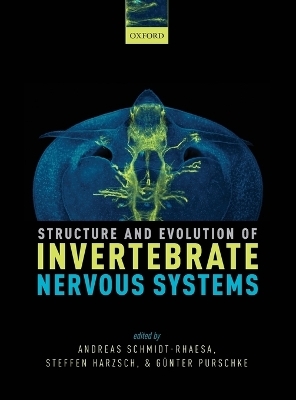
Structure and Evolution of Invertebrate Nervous Systems
Oxford University Press (Verlag)
978-0-19-968220-1 (ISBN)
The nervous system is particularly fascinating for many biologists because it controls animal characteristics such as movement, behavior, and coordinated thinking. Invertebrate neurobiology has traditionally been studied in specific model organisms, whilst knowledge of the broad diversity of nervous system architecture and its evolution among metazoan animals has received less attention. This is the first major reference work in the field for 50 years, bringing together many leading evolutionary neurobiologists to review the most recent research on the structure of invertebrate nervous systems and provide a comprehensive and authoritative overview for a new generation of researchers.
Presented in full colour throughout, Structure and Evolution of Invertebrate Nervous Systems synthesizes and illustrates the numerous new findings that have been made possible with light and electron microscopy. These include the recent introduction of new molecular and optical techniques such as immunohistochemical staining of neuron-specific antigens and fluorescence in-situ-hybridization, combined with visualization by confocal laser scanning microscopy. New approaches to analysing the structure of the nervous system are also included such as micro-computational tomography, cryo-soft X-ray tomography, and various 3-D visualization techniques. The book follows a systematic and phylogenetic structure, covering a broad range of taxa, interspersed with chapters focusing on selected topics in nervous system functioning which are presented as research highlights and perspectives.
This comprehensive reference work will be an essential companion for graduate students and researchers alike in the fields of metazoan neurobiology, morphology, zoology, phylogeny and evolution.
Andreas Schmidt-Rhaesa studied biology at the universities in Gießen and Göttingen, Germany, where he received his PhD in 1996, working on the ultrastructure and phylogeny of horsehair worms (Nematomorpha). As postdoc, he worked in Jim Garey´ s lab at the Duquesne University in Pittsburgh and at the University of South Florida in Tampa, USA on molecular systematics of nematomorphs. Between 1998 and 2004 he was scientific assistant in the working group of Thomas Bartolomaeus at the University of Bielefeld, where he then did a postdoc between 2004 and 2007. Since April 2007 he has been Curator for Lower Invertebrates at the Zoological Museum of the University of Hamburg. His research interests include animal morphology and systematics, with particular interest in the taxa Nematomorpha, Gastrotricha and Priapulida. Steffen Harzsch obtained his PhD from the University of Bielefeld, Germany in 1995 working on neurogenesis in crustacean larvae at the Department of Neurobiology and in the lab of Klaus Anger at the Marine Biological Station on the island of Helgoland in the North Sea. After a postodc at Wellesley College, Massachusetts, and a Heisenberg Fellowship of the German Research Foundation, he worked from 2007 to 2008 as a group leader for neuroanatomy in the Department of Evolutionary Neuroethology at the Max Planck Institute for Chemical Ecology in Jena, Germany. In 2009, he received tenure as a full Professor of Cytology and Evolutionary Biology at the Ernst Moritz Arndt University of Greifswald, Germany. His expertise is in studies on neurophylogeny and NeuroEvoDevo of arthropods and Chaetognatha. Günter Purschke, Professor at the University of Osnabrueck, Germany, is working on morphology, systematics, phylogeny and evolution of Annelida and related taxa. His research interests currently focus on evolution and diversity of photoreceptor cells and eyes, of the central nervous system and body wall musculature. He studied biology and chemistry at the University of Göttingen, and earned his PhD in Zoology in 1984. He was subsequently assistant at the University of Osnabrueck to the chair of Systematic Zoology (Prof. W. Westheide). After having received the venia legendi for Zoology (1997) he was appointed as extraordinary professor in 2002. Since 2004 he has been working with the chair of Zoology and Developmental Biology (Professor A. Paululat).
1. Introduction ; 2. Perspective - How to write an Invertebrate Anatomy Book ; 3. Porifera ; 4. Perspective - Evolution of neural cell types ; 5. Cnidaria ; 6. Ctenophora ; 7. Acoelomorpha ; 8. Xenoturbella ; 9. Perspective -The first brain ; 10. Free living Plathelminthes ; 11. Neodermata ; 12. Gnathostomulida ; 13. Rotifera ; 14. Acanthocephala ; 15. Gastrotricha ; 16. Nemertini ; 17. Kamptozoa (Entoprocta) ; 18. Mollusca: Caudofoveata, Monoplacophora, Polyplacophora, Scaphopoda, Solenogastres ; 19. Mollusca: Bivalvia ; 20. Mollusca: Gastropoda ; 21. Mollusca: Cephalopoda ; 22. Annelida: Myzostomida ; 23. Annelida: Sipuncula ; 24. Annelida: Basal groups and Pleistoannelida ; 25. Perspective - Nervous system development in bilaterian larvae - testing the concept of 'primary larvae' ; 26. Bryozoa (Ectoprocta) ; 27. Brachiopoda ; 28. Phoronida ; 29. Cycliophora ; 30. Cycloneuralia ; 31. Tardigrada ; 32. Onychophora ; 33. Perspective - Heads and Brains in Arthropods: 40 years after the 'endless dispute' ; 34. Perspective - Brain Atlases for studying neuronal circuitry in arthropods ; 35. Pycnogonida (Pantopoda) ; 36. Xiphosura ; 37. Scorpiones ; 38. Arachnida (exkl. Scorpiones) ; 39. Myriapoda ; 40. Perspective - Evolution of neurogenesis in arthropods - open questions and future directions ; 41. Research Spotlight - Adult neurogenesis in the decapod crustacean brain: The immune system supplies neural progenitors ; 42. Cephalocarida ; 43. Maxillopoda and Branchiopoda ; 44. Remipedia ; 45. Malacostraca ; 46. Perspective - Evolutionary aspects of motor control and coordination: the central pattern generators in the crustacean stomatogastric and swimmeret systems ; 47. Research Spotlight - The brain of Hexapoda ; 48. Research Spotlight - Olfactory coding in Drosophila melanogaster ; 49. Research Spotlight - Insect polarisation vision: peripheral and central mechanisms ; 50. Chaetognatha ; 51. Echinodermata ; 52. Hemichordata ; 53. Tunicata ; 54. Acrania ; 55. Perspective - The Origin of Vertebrate Neural Organization
| Erscheinungsdatum | 10.02.2016 |
|---|---|
| Verlagsort | Oxford |
| Sprache | englisch |
| Maße | 226 x 281 mm |
| Gewicht | 2930 g |
| Themenwelt | Naturwissenschaften ► Biologie ► Evolution |
| Naturwissenschaften ► Biologie ► Genetik / Molekularbiologie | |
| Naturwissenschaften ► Biologie ► Zoologie | |
| ISBN-10 | 0-19-968220-8 / 0199682208 |
| ISBN-13 | 978-0-19-968220-1 / 9780199682201 |
| Zustand | Neuware |
| Informationen gemäß Produktsicherheitsverordnung (GPSR) | |
| Haben Sie eine Frage zum Produkt? |
aus dem Bereich


